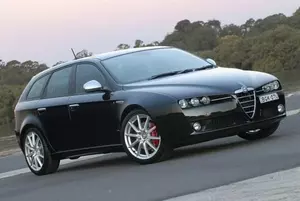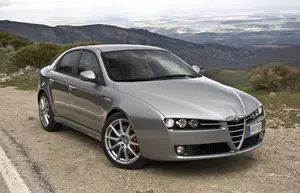
| Vehicle | Curb weight | Difference from world's smallest | Weight to power ratio | 0—60 mph acceleration ratio | Consumption ratio |
|---|---|---|---|---|---|
| 1.7 TBi |
1480 kg / 3263 lbs |
1055 kg (2326 lbs) heavier | 7 kg to 1 hp | 197 kg/s (434 lbs/s) |
178 kg/L (392 lbs/L) |
| 1.8 MPI 16V |
1575 kg / 3473 lbs |
1150 kg (2536 lbs) heavier | 11 kg to 1 hp | 159 kg/s (351 lbs/s) |
202 kg/L (445 lbs/L) |
| 1.9 JTDM |
1585 kg / 3495 lbs |
1160 kg (2558 lbs) heavier | 11 kg to 1 hp | 172 kg/s (379 lbs/s) |
220 kg/L (485 lbs/L) |
| 1.9 JTS |
1530 kg / 3374 lbs |
1105 kg (2437 lbs) heavier | 10 kg to 1 hp | 163 kg/s (359 lbs/s) |
174 kg/L (384 lbs/L) |
| 2.2 JTS |
1540 kg / 3396 lbs |
1115 kg (2459 lbs) heavier | 8 kg to 1 hp | 181 kg/s (399 lbs/s) |
167 kg/L (368 lbs/L) |
| 2.4 JTDM |
1680 kg / 3704 lbs |
1255 kg (2767 lbs) heavier | 8 kg to 1 hp | 205 kg/s (452 lbs/s) |
210 kg/L (463 lbs/L) |
| 3.2 V6 Q4 |
1730 kg / 3815 lbs |
1305 kg (2878 lbs) heavier | 7 kg to 1 hp | 251 kg/s (553 lbs/s) |
142 kg/L (313 lbs/L) |
| Vehicle | 1.7 TBi |
|---|---|
| Curb weight |
1480 kg / 3263 lbs |
| Difference from world's smallest | 1055 kg (1055 lbs) heavier |
| Weight to power ratio | 7 kg to 1 hp |
| 0—60 mph acceleration ratio | 197 kg/s (434 lbs/s) |
| Consumption ratio |
178 kg/L (392 lbs/L) |
| Vehicle | 1.8 MPI 16V |
| Curb weight |
1575 kg / 3473 lbs |
| Difference from world's smallest | 1150 kg (1150 lbs) heavier |
| Weight to power ratio | 11 kg to 1 hp |
| 0—60 mph acceleration ratio | 159 kg/s (351 lbs/s) |
| Consumption ratio |
202 kg/L (445 lbs/L) |
| Vehicle | 1.9 JTDM |
| Curb weight |
1585 kg / 3495 lbs |
| Difference from world's smallest | 1160 kg (1160 lbs) heavier |
| Weight to power ratio | 11 kg to 1 hp |
| 0—60 mph acceleration ratio | 172 kg/s (379 lbs/s) |
| Consumption ratio |
220 kg/L (485 lbs/L) |
| Vehicle | 1.9 JTS |
| Curb weight |
1530 kg / 3374 lbs |
| Difference from world's smallest | 1105 kg (1105 lbs) heavier |
| Weight to power ratio | 10 kg to 1 hp |
| 0—60 mph acceleration ratio | 163 kg/s (359 lbs/s) |
| Consumption ratio |
174 kg/L (384 lbs/L) |
| Vehicle | 2.2 JTS |
| Curb weight |
1540 kg / 3396 lbs |
| Difference from world's smallest | 1115 kg (1115 lbs) heavier |
| Weight to power ratio | 8 kg to 1 hp |
| 0—60 mph acceleration ratio | 181 kg/s (399 lbs/s) |
| Consumption ratio |
167 kg/L (368 lbs/L) |
| Vehicle | 2.4 JTDM |
| Curb weight |
1680 kg / 3704 lbs |
| Difference from world's smallest | 1255 kg (1255 lbs) heavier |
| Weight to power ratio | 8 kg to 1 hp |
| 0—60 mph acceleration ratio | 205 kg/s (452 lbs/s) |
| Consumption ratio |
210 kg/L (463 lbs/L) |
| Vehicle | 3.2 V6 Q4 |
| Curb weight |
1730 kg / 3815 lbs |
| Difference from world's smallest | 1305 kg (1305 lbs) heavier |
| Weight to power ratio | 7 kg to 1 hp |
| 0—60 mph acceleration ratio | 251 kg/s (553 lbs/s) |
| Consumption ratio |
142 kg/L (313 lbs/L) |

| Vehicle | Curb weight | Difference from world's smallest | Weight to power ratio | 0—60 mph acceleration ratio | Consumption ratio |
|---|---|---|---|---|---|
| 1.7 TBi |
1430 kg / 3153 lbs |
1005 kg (2216 lbs) heavier | 7 kg to 1 hp | 196 kg/s (432 lbs/s) |
177 kg/L (390 lbs/L) |
| 1.8 MPI 16V |
1525 kg / 3363 lbs |
1100 kg (2426 lbs) heavier | 11 kg to 1 hp | 157 kg/s (346 lbs/s) |
201 kg/L (443 lbs/L) |
| 1.9 JTDM |
1535 kg / 3385 lbs |
1110 kg (2448 lbs) heavier | 10 kg to 1 hp | 172 kg/s (379 lbs/s) |
256 kg/L (564 lbs/L) |
| 2.2 JTS |
1490 kg / 3285 lbs |
1065 kg (2348 lbs) heavier | 8 kg to 1 hp | 177 kg/s (390 lbs/s) |
159 kg/L (351 lbs/L) |
| 1.9 JTS |
1480 kg / 3263 lbs |
1055 kg (2326 lbs) heavier | 9 kg to 1 hp | 161 kg/s (355 lbs/s) |
170 kg/L (375 lbs/L) |
| 2.4 JTD |
1630 kg / 3594 lbs |
1205 kg (2657 lbs) heavier | 8 kg to 1 hp | 206 kg/s (454 lbs/s) |
206 kg/L (454 lbs/L) |
| 3.2 JTS V6 24V |
1740 kg / 3837 lbs |
1315 kg (2900 lbs) heavier | 7 kg to 1 hp | 256 kg/s (564 lbs/s) |
144 kg/L (318 lbs/L) |
| 3.2 JTS |
1740 kg / 3837 lbs |
1315 kg (2900 lbs) heavier | 7 kg to 1 hp | 260 kg/s (573 lbs/s) |
151 kg/L (333 lbs/L) |
| Vehicle | 1.7 TBi |
|---|---|
| Curb weight |
1430 kg / 3153 lbs |
| Difference from world's smallest | 1005 kg (1005 lbs) heavier |
| Weight to power ratio | 7 kg to 1 hp |
| 0—60 mph acceleration ratio | 196 kg/s (432 lbs/s) |
| Consumption ratio |
177 kg/L (390 lbs/L) |
| Vehicle | 1.8 MPI 16V |
| Curb weight |
1525 kg / 3363 lbs |
| Difference from world's smallest | 1100 kg (1100 lbs) heavier |
| Weight to power ratio | 11 kg to 1 hp |
| 0—60 mph acceleration ratio | 157 kg/s (346 lbs/s) |
| Consumption ratio |
201 kg/L (443 lbs/L) |
| Vehicle | 1.9 JTDM |
| Curb weight |
1535 kg / 3385 lbs |
| Difference from world's smallest | 1110 kg (1110 lbs) heavier |
| Weight to power ratio | 10 kg to 1 hp |
| 0—60 mph acceleration ratio | 172 kg/s (379 lbs/s) |
| Consumption ratio |
256 kg/L (564 lbs/L) |
| Vehicle | 2.2 JTS |
| Curb weight |
1490 kg / 3285 lbs |
| Difference from world's smallest | 1065 kg (1065 lbs) heavier |
| Weight to power ratio | 8 kg to 1 hp |
| 0—60 mph acceleration ratio | 177 kg/s (390 lbs/s) |
| Consumption ratio |
159 kg/L (351 lbs/L) |
| Vehicle | 1.9 JTS |
| Curb weight |
1480 kg / 3263 lbs |
| Difference from world's smallest | 1055 kg (1055 lbs) heavier |
| Weight to power ratio | 9 kg to 1 hp |
| 0—60 mph acceleration ratio | 161 kg/s (355 lbs/s) |
| Consumption ratio |
170 kg/L (375 lbs/L) |
| Vehicle | 2.4 JTD |
| Curb weight |
1630 kg / 3594 lbs |
| Difference from world's smallest | 1205 kg (1205 lbs) heavier |
| Weight to power ratio | 8 kg to 1 hp |
| 0—60 mph acceleration ratio | 206 kg/s (454 lbs/s) |
| Consumption ratio |
206 kg/L (454 lbs/L) |
| Vehicle | 3.2 JTS V6 24V |
| Curb weight |
1740 kg / 3837 lbs |
| Difference from world's smallest | 1315 kg (1315 lbs) heavier |
| Weight to power ratio | 7 kg to 1 hp |
| 0—60 mph acceleration ratio | 256 kg/s (564 lbs/s) |
| Consumption ratio |
144 kg/L (318 lbs/L) |
| Vehicle | 3.2 JTS |
| Curb weight |
1740 kg / 3837 lbs |
| Difference from world's smallest | 1315 kg (1315 lbs) heavier |
| Weight to power ratio | 7 kg to 1 hp |
| 0—60 mph acceleration ratio | 260 kg/s (573 lbs/s) |
| Consumption ratio |
151 kg/L (333 lbs/L) |